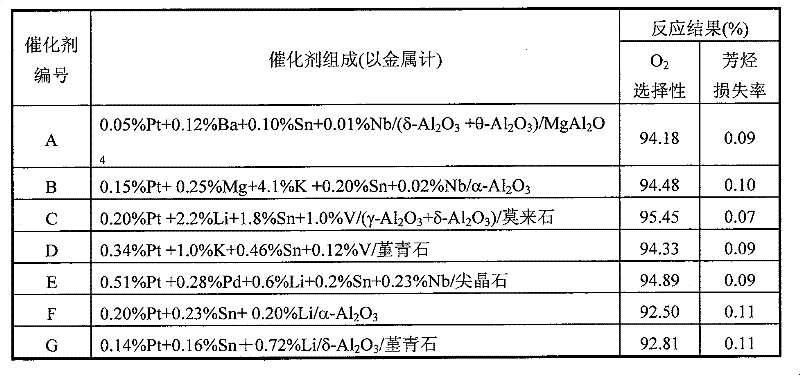Catalyst for hydrogen selective catalytic combustion reaction in ethyl benzene dehydrogenation process
A technology of ethylbenzene dehydrogenation and catalytic combustion, applied in the direction of physical/chemical process catalysts, metal/metal oxide/metal hydroxide catalysts, hydrocarbons, etc., can solve the problem of insufficient catalyst selectivity and achieve high-quality hydrogen The effect of catalytic combustion selectivity, high combustion activity and good technical effect
- Summary
- Abstract
- Description
- Claims
- Application Information
AI Technical Summary
Problems solved by technology
Method used
Image
Examples
Embodiment 1
[0021] 40 grams of 15% alumina sol, 60 grams of 2% glycerin solution, and 0.5 grams of Span 80 were made into slurry. Then add 0.5 grams of potassium feldspar and 40 grams of γ-Al with a particle size below 20 microns to this mixture 2 o 3 powder (specific surface area 200 m 2 / gram). After stirring for about ten minutes, add 4.0 g of Ba(MO 3 ) 2 and 1.5 g of 50% SnCl 4 As an aqueous solution, the resulting slurry was ball milled for 4 hours at room temperature to control the particle size below 10 microns. Slurry spraying to MgAl particle size 4 mm 2 o 4 On the pellet, dry at 80°C for 2 hours, then heat up to 100°C and dry again for 2 hours, and finally bake at 1100°C for 6 hours to obtain a layered composite carrier with a composition of 13% (δ-Al 2 o 3 +θ-Al 2 o 3 ) / 87%MgAl 2 o 4 . Scanning electron microscopy shows that the thickness of the coating is about 90 microns, and the specific surface area of the coating is 165 meters 2 / gram.
[0022] Niobium ox...
Embodiment 2
[0024] Dissolve niobium oxalate in water, heat to 80 °C, and impregnate in 4 mm-Al 2 o 3 pellets, and then dried at 150°C for 2 hours. SnCl 2 , potassium chloride, magnesium chloride and chloroplatinic acid were dissolved in water respectively, and the pH of the solution was adjusted to about 3 with HCl, and then the solution was heated to 75°C and immersed in 4 mm of -Al 2 o 3pellets, then dried at 150°C for 2 hours, and then reduced in a hydrogen atmosphere at 600°C for 2 hours to obtain Catalyst B, whose composition is shown in Table 2. The radial distribution of the constituent elements of the catalyst is measured by EDX, and the thickness of the effective active layer is 80 microns.
Embodiment 3
[0026] 35 grams of alumina sol (containing 25% mass ratio of alumina), 5 grams of 40% silica sol, 60 grams of 4% cyclodextrin solution, 2.0 grams of ammonium metavanadate, 1.0 grams of hexadecyl trimethyl Ammonium bromide was made into a slurry. Then add 0.4 grams of calcium silicate, 0.3 grams of potassium carbonate and 40 grams of δ-Al with a particle size of 20 microns or less to this mixture. 2 o 3 pink. After stirring for about ten minutes, add 2.0 g of 50% SnCl 4 As an aqueous solution, the resulting slurry was ball milled for 4 hours at room temperature to control the particle size below 10 microns. The slurry was sprayed onto mullite pellets with a particle size of 4 mm, dried at 80°C for 2 hours, then heated to 150°C and dried again for 2 hours, and finally calcined at 900°C for 6 hours to obtain a layered composite carrier with a composition of 16% (γ -Al 2 o 3 +δ-Al 2 o 3 ) / 84% mullite. The scanning electron microscope shows that the thickness of the coatin...
PUM
| Property | Measurement | Unit |
|---|---|---|
| particle size | aaaaa | aaaaa |
| thickness | aaaaa | aaaaa |
| specific surface area | aaaaa | aaaaa |
Abstract
Description
Claims
Application Information
 Login to View More
Login to View More - R&D
- Intellectual Property
- Life Sciences
- Materials
- Tech Scout
- Unparalleled Data Quality
- Higher Quality Content
- 60% Fewer Hallucinations
Browse by: Latest US Patents, China's latest patents, Technical Efficacy Thesaurus, Application Domain, Technology Topic, Popular Technical Reports.
© 2025 PatSnap. All rights reserved.Legal|Privacy policy|Modern Slavery Act Transparency Statement|Sitemap|About US| Contact US: help@patsnap.com


